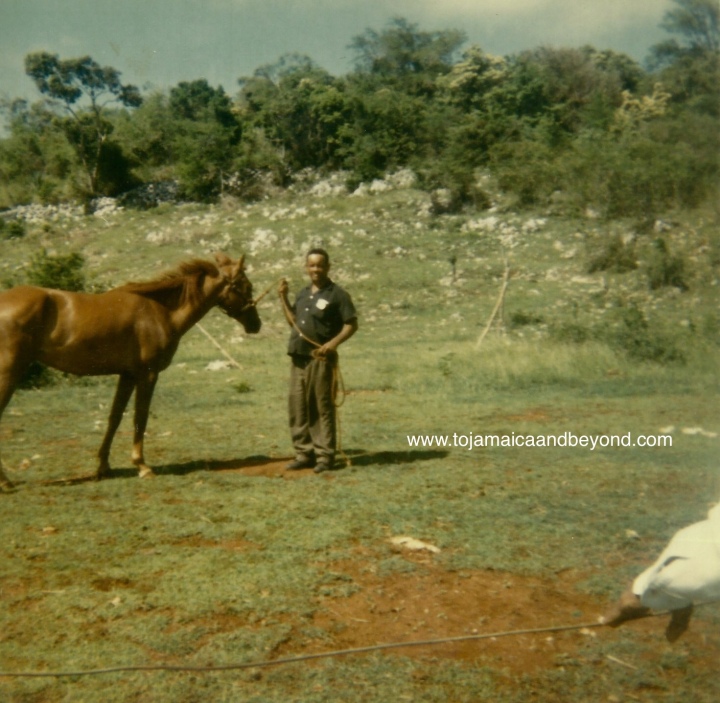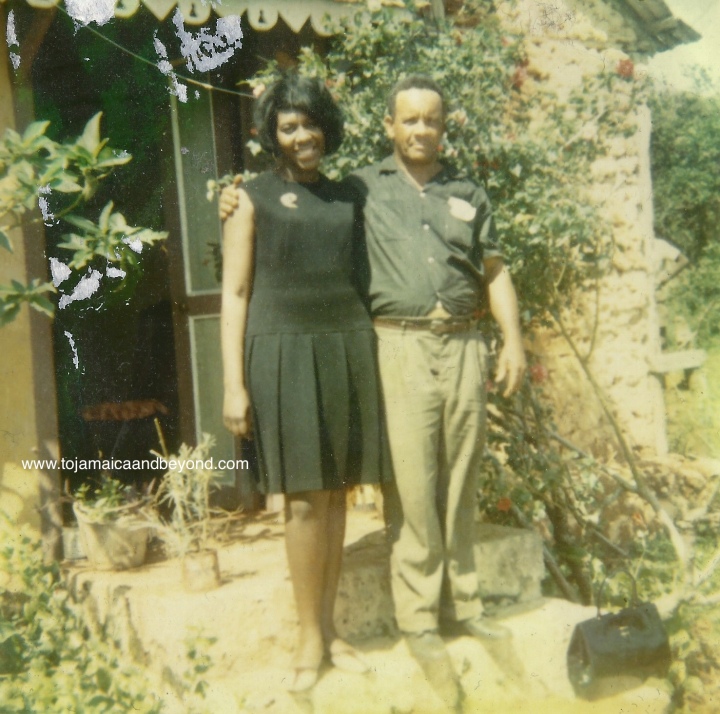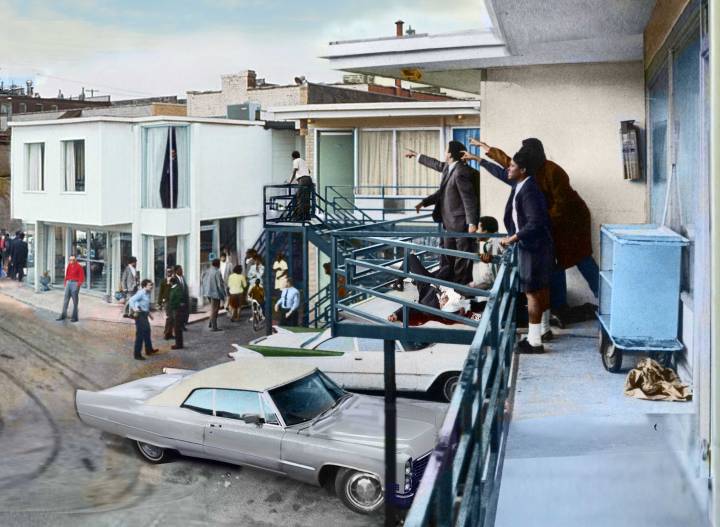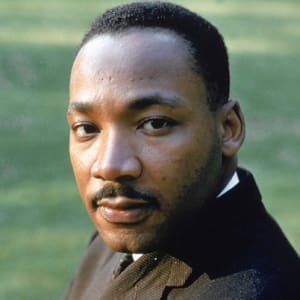The previous blog, 1963 – Jamaican Wedding Cake contained the usual selection of old-time black and white photographs from Cecil Hodgson’s albums. The years were now moving quickly forward and the world of colour photographs are beginning to appear more often. We are now in the year 1964….
SOUTHFIELD 1964: My dad’s sister, Cisline Hodgson, was still ‘Back Home’ at Southfield. During this year she married her Jamaican, partner Kenworth Stanford Powell.

Cissy’s uncle, Linton Hodgson was also at the wedding, being Back Home, having come over from New York. Linton was Cecil’s brother. Also at the wedding was the widowed education teacher, Inspector Reginald Speid, who had helped to raise Cissy with his late wife, Dorcas (Mabel Bent’s sister)
Aunt Cissy’s family would eventually go on to be the last members of the Southfield Hodgson’s to leave the island of Jamaica.


WEST BROMWICH 1965: Ida Mae Burkley visited England again.
In 1965, Aunt Mae came to England again and stayed at Uncle Cecil’s. I took her to the Lewisham pub then afterwards treated her to an English fish & chip supper. (Telephone conversation with my dad Renford Hodgson sometime in the early 2000’s)
We now skip forward two years….
NEW YORK 1965: Maurice Vincent Hodgson (Vin) was the son of Cecil’s eldest brother, Maurice Hugh Hodgson. Vin had left Southfield many years before to go to America. He had a wife and family in New York. With his roots now firmly set in New York, he had been away from his Jamaican home for 24 years and had not once ventured Back Home since his move to the States.
SOUTHFIELD 1967: Vin and his wife Mildred Hodgson – née Porcher – travelled to Jamaica. Mildred had never seen her husband’s childhood home, although she had probably heard much about it from her husband. They visited Vin’s Uncle and Aunt, Les & Phyllis Hodgson at Southfield Pen.
Self Sufficient
When Vin had left home to go to America in 1943, there used to be many family members at Southfield – his grandparents Mass Teddy & Mabel, uncles & aunts, and many cousins including my dad, Renford. The family had since dispersed, nearly all of them had now gone, either deceased or emigrated. Southfield Pen was now such a very different place, everything had changed.
Vin, recalled to me in 2002 that he moved into Southfield Pen as an infant in 1924 and lived there with his grandparents until he was 19 years old. He had lots of good memories of his time at Southfield.
As he got older, Vin would ‘cultivate’ in the field with his elderly grandfather Mass Teddy. On occasions he would even visit the rum bar with his grandfather. Vin was given chores and used to ride a donkey 7 miles to Teddy’s sister Emmy to fetch mango. He said he remembered Mass Teddy and his children making their own rope on an old antique mangle, emphasising to me that the Southfield Hodgson’s had always been a self-sufficient farming family that wanted for nothing.
The Hodgson’s were long-established at Southfield and had lived by their own means producing their own foodstuffs and other items. They grew and produced everything they needed, tobacco, coffee, oranges, lemons, mango, meat, poultry, vegetables, fruit, milk, eggs and just about everything else. They didn’t buy anything!
Les Hodgson had taken over the farming residence and been the owner of Southfield Pen since his father’s death a decade before. Although he still rode horses and reared animals just like his Southfield ancestors had done centuries ago, Les would now drive his blue pick up truck down to the local stores to buy local produce.
How life had changed at Southfield since Vin had been away.




Bauxite
Since becoming an independent country in 1962, Jamaica had developed strong ties with the United States, who had tapped into the Jamaican market and discovered Bauxite (Aluminium) in the red dirt of Saint Elizabeth. America was now heavily mining the soil to extract this precious commodity.
Farming slacked after 1962 in Saint Elizabeth. The process of working the red soil to extract bauxite had perished the plants and the dust poisoned the farms. People then began buying ready food from the stores. (Telephone conversation with Maurice Vincent Hodgson, sometime in the 2000’s)
It is unsure sure how long Vin & Mildred stayed at Southfield, but eventually their stay was over and it was now time for them to leave. Just as they were walking away from the Hodgson’s historical home, Mildred turned around to have just one last look at the house. Instinctively, she took her camera out and snapped the frontal view of her husbands former home, Southfield Pen Great House.
That was to be the last time that Vin ever saw Southfield. When he walked away that day, he made a promise, never to return, and he never did.
Everything had changed at Southfield. I made a promise never to go back there. Telephone conversation about 2002 with the late Maurice Vincent Hodgson of New York

The Hodgson Home
I’m extremely grateful that his wife Mildred, clicked the shutter on her camera that day in 1967. That colour photo turned out to be the oldest photograph in existence of the old Hodgson home. Or does an older one exist?

A quick detour to 2006….
A few years into the millennium – 39 years after she famously clicked the camera shutter at Southfield – Mildred mailed me some of the ‘original photographs’ from that visit. She sent them lovingly by old-fashioned ‘snail mail’ in a padded jiffy envelope. It was airmail from New York to West Bromwich, which I really appreciated. Thank you Mildred.

WEST BROMWICH 1968: Dad recalled that Ida Mae visited England yet again in 1968, visiting London first before staying in West Bromwich at her brother Cecil’s home for a few days.
AMERICA 1968: A half-century ago today, as I write, a black Baptist minister named Martin Luther King traveled to Memphis, Tennessee, to support and bring attention to a strike by more than 1,300 black sanitation workers.
No one knew that this journey to Tennessee would cost King his life and change the trajectory and course of the civil rights movement in America. This is a short summary of who Martin Luther King was, what he fought for and the historical moments that led up to his infamous death.

MEMPHIS, TENNESSEE: The rain was torrential at Memphis on the 1st February 1968. Black garbage collectors, however, were still required to work in those poor conditions. Robert Walker and Echol Cole took shelter from the rain in the back of a garbage truck, but the equipment malfunctioned and pulled them both into the compactor, horrificaly crushing them to death.
This incident cast a light on the poor working conditions and low wages that black sanitation workers faced. Just eleven days later on the 12th February, black sanitation workers walked off their jobs in protest and set up picket lines, holding up hundreds of signs with the words “I am a man”

Who Was Martin Luther King?
Martin Luther King was a Baptist minister from Atlanta, Georgia and was the country’s most famous civil rights activist. When he heard about the work stoppage he decided to go to Memphis, Tennessee, to bring national attention to the strike.
King was already well-known and had already come to national prominence in the United States by leading a bus boycott in Montgomery, Alabama, in 1955, after an African-American woman ‘Rosa Parks’ had been arrested for refusing to give up a front bus seat to a white man.
Civil Rights Movement
In the decade following the bus boycott, Martin Luther King became a civil rights leader, organizing non-violent protests for racial and economic equality. Regarding the bus boycott in 1955, King had organized a massive march on Washington to demand change, and gave a blistering speech on the National Mall, calling out the federal government for its “apathy and hypocrisy, its betrayal of the cause of justice.” Part of his inspirational speech that day included these words;
“I have a dream”
“That my four children will one day live in a nation where they will not be judged by the color of their skin, but by their character” King told the crowd”
King was later awarded the Nobel Peace Prize in October 1964.
Visited Jamaica
In June 1965, he visited the island of Jamaica. At Jamaica’s National Stadium in Kingston, King addressed a huge audience, where he was awarded the keys to the City of Kingston. The main stand at the stadium was packed with young Jamaicans. King’s tone was warm and personal.
He said he had never felt more at home anywhere in the world: “In Jamaica I feel like a human being.” This theme of identity and belonging was reiterated when King laid a wreath at the tomb of Jamaican National Hero Marcus Garvey, who had, he said, given African-Americans a “sense of personhood, a sense of manhood, a sense of somebodiness.”
After the visit, King recalled in a speech, the profound impact that Jamaica — and Jamaicans — had upon him. He may have captivated his audiences with his powerful oratory, but he was also captivated by what he saw as a multiracial nation.
“The other day Mrs King and I spent about ten days down in Jamaica …. I always love to go to that great island which I consider the most beautiful island in all the world. The government prevailed upon us to be their guests and spend some time and try to get a little rest while there on the speaking tour. And so for those days we travelled all over Jamaica. And over and over again I was impressed by one thing. Here you have people from many national backgrounds: Chinese, Indians, so-called Negroes, and you can just go down the line, Europeans, and people from many, many nations”
“Do you know they all live there and they have a motto in Jamaica, “Out of many people, one people.” And they say, “Here in Jamaica we are not Chinese, we are not Japanese, we are not Indians, we are not Negroes, we are not Englishmen, we are not Canadians. But we are all one big family of Jamaicans.” One day, here in America, I hope that we will see this and we will become one big family of Americans”
Back to 1968 again….
LORRAINE MOTEL, MEMPHIS: On the 3rd April 1968, Martin Luther King and his entourage checked into the Lorraine Motel, Memphis. The Lorraine was one of the few motels in Memphis that was known as being friendly to African-Americans.
Within hours after checking into Room 306, King, battling a bad cold, spoke to an overflow crowd at the Mason Temple Church. Many in the audience were striking sanitation workers. King gave his famous ‘Mountain Top’ speech, in which he spoke of his own mortality, powerfully telling the crowd,
“Ive seen the promised land”
“I may not get there with you, but I want you to know tonight, that we as a people, will get to the promised land”
King and his inner circle had been invited to have dinner at the home of the Rev. Samuel Billy Kyles, a Memphis minister. About 6 p.m., King, dressed in his trademark dark suit and tie, emerged from Room 306. Andrew Young, his close friend and partner in the civil rights movement, yelled up to him to grab his coat because the weather had turned chilly. But before he could answer, a shot rang out.
A bullet fired by white racist, James Earl Ray, hit King in the right cheek, shattering his jaw, several vertebrae and severing his spinal cord. He was rushed to St. Joseph’s Hospital, where he was pronounced dead at 7:05 p.m. The killer was arrested two months later at Heathrow Airport, London. He was later sentenced to life imprisonment in the United States.

Martin Luther King’s civil rights legacy lived on, helping to find racial equality for African-American’s In the United States….
“I say to you today, my friends, so even though we face the difficulties of today and tomorrow, I still have a dream. It is a dream deeply rooted in the American dream.
I have a dream
That one day this nation will rise up and live out the true meaning of its creed: ‘We hold these truths to be self-evident: that all men are created equal.’
I have a dream
That one day on the red hills of Georgia the sons of former slaves and the sons of former slave owners will be able to sit down together at the table of brotherhood.
I have a dream
That one day even the state of Mississippi, a state sweltering with the heat of injustice, sweltering with the heat of oppression, will be transformed into an oasis of freedom and justice.
I have a dream
That my four little children will one day live in a nation where they will not be judged by the color of their skin but by the content of their character. I have a dream today.
I have a dream
That one day, down in Alabama, with its vicious racists, with its governor having his lips dripping with the words of interposition and nullification; one day right there in Alabama, little black boys and black girls will be able to join hands with little white boys and white girls as sisters and brothers.
“I have a dream today”


Click the arrow on the audio player to hear ‘Georgia’ by Ray Charles
An interesting footnote to the singer Ray Charles….
In the 1960’s singer, Ray Charles ventured into black activism protesting and refusing to sing when he found that blacks and whites could not sit together at his concerts. He soon became friends with Martin Luther King. Both of these two African – American legends were born in Georgia.
Epilogue
“Three interesting events have been covered during today’s blog, 1964 to 1968 – Back Home. The theme of the stories being based on being ‘Back Home’ My Aunt Cissy’s marriage at Southfield, Vin and Mildred’s visit to Southfield and the assassination of Martin Luther King in Memphis. I found the last article about Martin Luther King powerful and thought-provoking. Yet again, enjoyable to research, discover and write the history of those three subjects.
Aunt Cissy’s marriage. Yet another event recorded in Cecil’s amazing family album. My thanks to Aunt Cissy for giving me the guest’s names in the photographs during a telephone conversation with her on the 3rd December 2004 (exactly 14 years ago today!)
My cousin, Vin was Mass Teddy and Mabel’s oldest grandchild, therefore he helped me to gain much knowledge, giving me lots interesting information of his time spent at Southfield. We spoke by phone many times.
When I received the Southfield Pen photographs from my cousin Mildred in 2006, I was mesmerised. I instantly telephoned and thanked her. I then copied them and posted them back to her by airmail. Mildred got back in touch with me and said “They were for you to keep, you didn’t have to send them back! Such a nice gesture. Thank you Mildred.
She told me that she was fortunate to have that full frontal photograph of the Hodgson Home because as she was walking away, for some reason she just turned around to have just one last look at the property and thought, I must take a photograph. It just goes to show that the best photo’s are not always the ones that are planned!
My dad lived at Southfield Pen for a while. He knew it as Southfield House and has fond memories and stories about it. He first told me about it in 1999 when I started researching, saying that his grandfather Mass Teddy told him about the antiquity of it, saying that his ancient ancestors, the Bromfield’s, used to live in it. Dad thought the property was about 250 years old.
I knew of Martin Luther King, having watched documentaries about him on English TV many years before I even took an interest in my families history. I didn’t know enough about how inspiring he was, the role he played in the civil rights movement, and the way that he helped in the fight for African-American racial equality in the United States.
Ray Charles sings about his hometown Georgia. I have always liked this song, but learning more about Martin Luther King, and the happenings at Southfield, ‘1964 to 1968 – Back Home’ takes on a whole new meaning.
Robert Roy Hodgson
“PRESERVING OUR HERITAGE”
The Next 5 Blogs Will Cover The Years: 1969 – 1979
1982 – 1985
1989 – 1990
1992
1994 – 1997


Dear Robert,
My sincere gratitude for your dedication in bringing our family history to those of us who were in the dark.
Continued success with your blog with the grace of God.
Thank you.
Your cousin Carol in Canada.
LikeLiked by 1 person
Hi Carol
Thank you for the nice comment again! I’m glad you find it interesting.
Keep reading and enjoy the rest of your christmas and the new year.
Your cousin, Rob
LikeLike